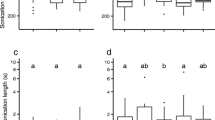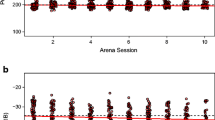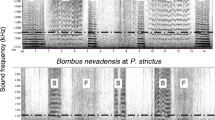Abstract
Many bees collect pollen by grasping the anthers of a flower and vibrating their flight muscles at high frequencies—a behavior termed sonication, or buzz-pollination. Here we compare buzz-pollination on Solanum lycopersicum (cherry tomatoes) by two bees that fill similar niches on different continents—in Australia, Amegilla murrayensis (blue-banded bee), and in North America, Bombus impatiens (bumblebee). We collected audio recordings of buzz-pollination and quantified the frequency and length of buzzes, as well as the total time spent per flower. We found that A. murrayensis buzzes at significantly higher frequencies (~350 Hz) than B. impatiens (~240 Hz) and flaps its wings at higher frequencies during flight. There was no difference in the length of a single buzz, but A. murrayensis spent less time on each flower, as B. impatiens buzzed the flower several times before departing, whereas A. murrayensis typically buzzed the flower only once. High-speed videos of A. murrayensis during buzz-pollination revealed that its physical interaction with the flower differs markedly from the mechanism described for Bombus and other bees previously examined. Rather than grasping the anther cone with its mandibles and shaking, A. murrayensis taps the anther cone with its head at the high buzzing frequencies generated by its flight muscles. This unique behavior, combined with its higher buzzing frequency and reduced flower visit duration, suggests that A. murrayensis may be able to extract pollen more quickly than B. impatiens, and points to the need for further studies directly comparing the pollination effectiveness of these species.




Similar content being viewed by others
References
Anderson GJ, Symon D (1988) Insect foragers on Solanum flowers in Australia. Ann Mo Bot Gard 75:842–852
Asada S, Ono M (1996) Crop pollination by Japanese bumblebees, Bombus spp. (Hymenoptera: Apidae): tomato foraging behavior and pollination efficiency. Appl Entomol Zool 31(4):581–586
Bell M, Spooner-Hart R, Haigh A (2006) Pollination of greenhouse tomatoes by the Australian blue banded bee Amegilla (Zonamegilla) holmesi (Hymenoptera: Apidae). J Econ Entomol 99(2):437–442
Buchmann SL (1983) Buzz pollination in angiosperms. In: Jones CE, Little RJ (eds) Handbook of experimental pollination biology. van Nostrand Reinhold Company Inc, New York, pp 73–113
Buchmann SL, Hurley JP (1978) A biophysical model for buzz pollination in angiosperms. J Theor Biol 72(4):639–657
Buchmann SL, Nabhan GP (1996) The forgotten pollinators. Island Press, Washington, DC
Burkart A, Lunau K, Schlindwein C (2011) Comparative bioacoustical studies on flight and buzzing of neotropical bees. J Pollinat Ecol 6(16):118–124
Cane JH, Buchmann SL (1989) Novel pollen-harvesting behavior by the bee Protandrena mexicanorum (Hymenoptera: Andrenidae). J Insect Behav 2(3):431–436
Corbet SA, Huang SQ (2014) Buzz pollination in eight bumblebee-pollinated Pedicularis species: Does it involve vibration-induced triboelectric charging of pollen grains? Ann Bot 114(8):1665–1674
Core Team R (2012) R: a language and environment for statistical computing. R Foundation for Statistical Computing, Vienna
De Luca PA, Vallejo-Marín M (2013) What’s the ‘buzz’about? The ecology and evolutionary significance of buzz-pollination. Curr Opin Plant Biol 16(4):429–435
De Luca PA, Bussiere LF, Souto-Vilaros D, Goulson D, Mason AC, Vallejo-Marín M (2013) Variability in bumblebee pollination buzzes affects the quantity of pollen released from flowers. Oecologia 172(3):805–816
Gegear RJ, Laverty TM (2001) The effect of variation among floral traits on the flower constancy of pollinators. In: Chittka L, Thomson JD (eds) Cognitive ecology of pollination. Animal behaviour and floral evolution. Cambridge University Press, Cambridge, pp 1–20
Harder LD (1990) Pollen removal by bumble bees and its implications for pollen dispersal. Ecology 71:1110–1125
Harder L, Barclay R (1994) The functional significance of poricidal anthers and buzz pollination: controlled pollen removal from Dodecatheon. Funct Ecol 8:509–517
Harder LD, Thomson JD (1989) Evolutionary options for maximizing pollen dispersal of animal-pollinated plants. Am Nat 133:323–344
Hogendoorn K, Steen Z, Schwarz MP (2000) Native Australian carpenter bees as a potential alternative to introducing bumble bees for tomato pollination in greenhouses. J Apic Res 39:67–74
Hogendoorn K, Gross CL, Sedgley M, Keller MA (2006) Increased tomato yield through pollination by native Australian Amegilla chlorocyanea (Hymenoptera: Anthophoridae). J Econ Entomol 99(3):828–833
Javorek S, Mackenzie K, Vander Kloet S (2002) Comparative pollination effectiveness among bees (Hymenoptera: Apoidea) on lowbush blueberry (Ericaceae: Vaccinium angustifolium). Ann Entomol Soc Am 95(3):345–351
Jesson LK, Barrett SC (2005) Experimental tests of the function of mirror-image flowers. Biol J Linn Soc 85(2):167–179
Josephson RK, Malamud JG, Stokes DR (2000) Asynchronous muscle: a primer. J Exp Biol 203(18):2713–2722
King MJ (1993) Buzz foraging mechanism of bumble bees. J Apic Res 32:41–49
King MJ, Buchmann SL (1996) Sonication dispensing of pollen from Solanum laciniatum flowers. Funct Ecol 10:449–456
King MJ, Buchmann SL (2003) Floral sonication by bees: mesosomal vibration by Bombus and Xylocopa, but not Apis (Hymenoptera: Apidae), ejects pollen from poricidal anthers. J Kans Entomol Soc 76:295–305
King MJ, Buchmann SL, Spangler H (1996) Activity of asynchronous flight muscle from two bee families during sonication (buzzing). J Exp Biol 199(10):2317–2321
MacKenzie K (1994) The foraging behavior of honey bees (Apis mellifera L) and bumble bees (Bombus spp) on cranberry (Vaccinium macrocarpon Ait). Apidologie 25:375–383
Michener CD (2000) The bees of the world. Johns Hopkins University Press, Baltimore
Michener CD, Winston ML, Jander R (1978) Pollen manipulation and selected activities and structures in the family Apidae. Univ Kans Sci Bull 51:575–601
Morandin L, Laverty T, Kevan P (2001) Bumble bee (Hymenoptera: Apidae) activity and pollination levels in commercial tomato greenhouses. J Econ Entomol 94(2):462–467
Neff JL, Simpson BB (1988) Vibratile pollen-harvesting by Megachile mendica Cresson (Hymenoptera, Megachilidae). J Kans Entomol Soc 61:242–244
Roberts J, Cartar RV (2015) Shape of wing wear fails to affect load lifting in bumble bees with experimental wing wear. Can J Zool 93(7):531–537
Signal Developers (2013) Signal: signal processing. http://r-forge.r-project.org/projects/signal/last. Accessed Oct 2015
Sueur J, Aubin T, Simonis C (2008) Equipment review: seewave, a free modular tool for sound analysis and synthesis. Bioacoustics 18(2):213–226
Thorp RW, Estes JR (1975) Intrafloral behavior of bees on flowers of Cassia fasciculata. J Kans Entomol Soc 48:175–184
Wickham H (2009) ggplot2: elegant graphics for data analysis. Springer, New York
Wilson P, Thomson JD (1991) Heterogeneity among floral visitors leads to discordance between removal and deposition of pollen. Ecology 72:1503–1507
Zimmerman M (1982) Optimal foraging: random movement by pollen collecting bumblebees. Oecologia 53(3):394–398
Acknowledgments
The authors thank Christopher De Ieso and Remko Leijs for help in collecting data in the Adelaide Botanic Garden, as well as the staff of the Adelaide Botanic Garden, notably Carolyn Sawtell and Robert Hatcher, for allowing us to conduct research with their plants. We would also like to thank Robin Hopkins for helpful suggestions on the manuscript. This project was funded by a Putnam Expedition Grant to C.S. from the Harvard Museum of Comparative Zoology and by the National Science Foundation (CAREER IOS-1253677) to S.C.
Author information
Authors and Affiliations
Corresponding author
Additional information
Handling Editor: Heikki Hokkanen.
Electronic supplementary material
Below is the link to the electronic supplementary material.
Online Resource 2
High-speed video of Amegilla murrayensis collecting pollen from a Solanum lycopersicum flower, demonstrating its unique “head-butting” behavior. (MP4 90313 kb)
Online Resource 3
High-speed video of Bombus impatiens collecting pollen from a Solanum lycopersicum flower, grasping the anthers with its mandibles. (MP4 27931 kb)
Online Resource 4
High-speed video of Lipotriches flavoviridis collecting pollen from a Dianella perfragrans flower, grasping the anthers with its mandibles. (MP4 37280 kb)
Rights and permissions
About this article
Cite this article
Switzer, C.M., Hogendoorn, K., Ravi, S. et al. Shakers and head bangers: differences in sonication behavior between Australian Amegilla murrayensis (blue-banded bees) and North American Bombus impatiens (bumblebees). Arthropod-Plant Interactions 10, 1–8 (2016). https://doi.org/10.1007/s11829-015-9407-7
Received:
Accepted:
Published:
Issue Date:
DOI: https://doi.org/10.1007/s11829-015-9407-7




